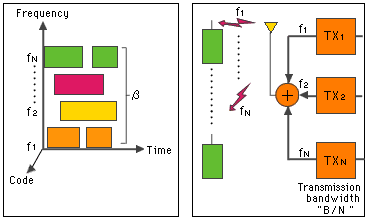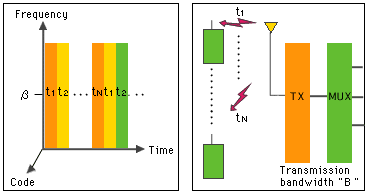Multiple Access -2.FDMA/TDMA
FDMA is a multiple access system that has been widely adopted in existing analog system for portable and automobile telephones. It assigns a different carrier wave frequency to each active user. A frequency synthesizer is used to set the transmission and reception frequencies.
TDMA splits a single carrier wave into time slots and distributes the slots among multiple users. The communications channels essentially consist of many units called time slots over a certain time cycle, which make it possible for one frequency channel to be effectively utilized by multiple users as each uses a different time slot. This system is widely used in the field of digital portable and automobile telephones and mobile satellite communications. Under the TDMA system, the PDC system uses FDD (in which the uplink/downlink communications frequencies differ), and the PHS system uses TDD (in which the uplink/downlink communications frequencies are the same).
In wideband TDMA used for high-speed digital transmissions, selective frequency fading due to the usage of multiple paths can become a problem. This requires steps to limit the width of the bandwidth to an extent that overcomes selective fading, or measures to adopt improvement technologies such as adaptive equalization. Moreover, a high-precision synchronization circuit is also necessary on the mobile unit side to carry out intermittent burst signal transmission.

FDMA scheme concept

Concept of TDMA
![]() Created 1999/03
Created 1999/03
